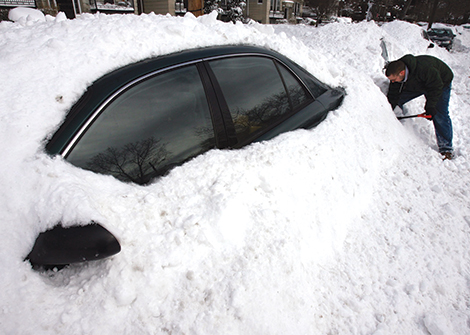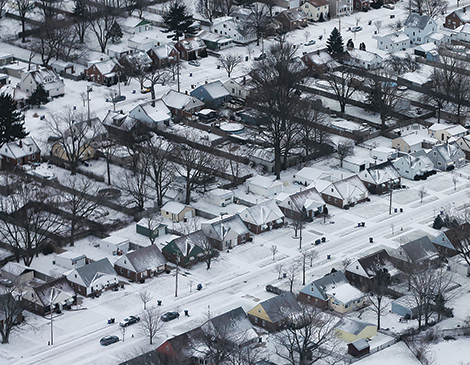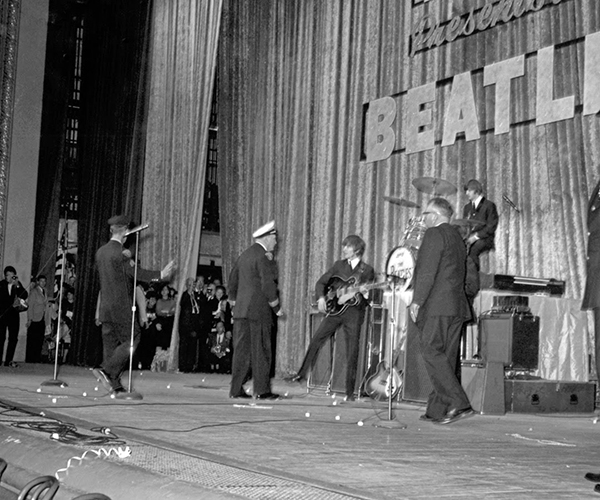As the fall turns to winter, Northeast Ohioans cringe as the first Winter Storm Warning appears on their phone or scrolls across the top of their television screen. There are a number of reasons for this reaction. They worry that school may be canceled and child care must be arranged, that they’ll have to make a tougher trek into work or that any number of main streets may or may not be plowed. It can be easy to feel as if during these times — snow events, as the City of Cleveland refers to them — residents are reliant upon the city to keep life moving at a somewhat-normal pace. And in many ways, they are. It’s in this moment that more than 60 plow trucks in Cleveland rev up, ready to clear the way for life to proceed undeterred.

It’s dark and snowy on a cold December night. The clock ticks just past midnight. The roads are mostly empty and with good reason. Inside homes across Cleveland, residents are wondering what the trek to work will have in store for them as the sun rises or what alternative plans they’ll need to make for their children if school is canceled.
On the roads, people like John Zindroski are driving plow trucks for the City of Cleveland, doing their best to ensure that business as usual, or something close to it, can be conducted by the end of his shift.
“I love what I do,” says Zindroski, a heavy equipment operator for the city of Cleveland.
Zindroski’s job isn’t an easy one. It’s a job that requires skill and toughness. It’s also one that deserves patience from the public.
“One of the things that people need to understand is that we are workers. We’re not miracle workers,” says Zindroski. “It’s very, very stressful.”
In 2022, days after Mayor Justin Bibb took office, a significant snowstorm hit Cleveland. When the city was criticized for its response, the mayor admitted that it needed to modernize its approach to snow removal. More than 100 new drivers were hired, and tech tools like tablets were installed in trucks. Work began to create more efficiencies in routes altogether.
These updates have made life easier for drivers. But even when all goes right, it’s very difficult work.
“I take it as a challenge every day. I work third shift, so I’m usually doing it at night when there aren’t a whole lot of people out and I can do a good job,” Zindroski says. “I know that when people get up in the morning and they’re leaving for work that they’re clear and they can go out to their means and get to where they got to go. And I feel that I accomplished what I set out to do as an employee of the City of Cleveland.”
In past years, that hasn’t always been a pleasant experience. Now, the city is hoping for a better outcome thanks to a few changes in the way things are done.
Director of Public Works Frank Williams returned to Cleveland last winter after a seven-year stint in Columbus. Two of Ohio’s biggest cities have plenty of things in common, but their winters are drastically different.
In his second winter overseeing the department, Williams is hoping that technological advancements and strong preparation will help to create a better experience for Cleveland
residents.
“I always say, ‘Treat it like 10 [inches].’ Just treat it every time it’s going to snow as if it’s going to be 10 inches,” Williams says. “We plan for a major event every time.”
Obviously, each time it snows doesn’t bring nearly a foot of the fluffy white stuff coming down from the clouds. There are times when prep could be done for 10 inches and only a dusting hits the grounds. In this way, the city takes a “better safe than sorry” approach.
That planning means quite a few things. It means training, ensuring that equipment is maintained to the point they’re worthy of being on the road and making sure there are enough supplies, such as rock salt, to make it through the event. But the planning goes beyond just ensuring the city is ready for one single snow event, instead planning for an entire season.
Cleveland has done that by improving the technology used to clean up its streets during a snow event.
Installing GPS into the trucks has created a new tool to help drivers respond to snow events. Previously, believe it or not, drivers were using paper maps to follow their routes.
“We’ve been working on the implementation of route optimization over the last couple of seasons. The first phase of it was the incorporation of taking the maps and making them digital, and they are now on tablets inside of the truck,” Williams says. “This year, we’ve been working on the actual turn-by-turn navigation of the routes within the residential areas to try to gain some efficiencies, balancing the city, taking in data, making sure these maps are updated and actually based on GIS [Geographic Information System] and not older maps or one of the things that we had, and hopefully what it will help to do is eliminate missed streets.”
All of that technology doesn’t come without a learning curve, however. For folks who have been on the road for years, doing something a different way can be a challenge.
“At first, they were a little resistant, but now they like it,” says District Unit Leader Monique Graves of the GPS tablets in the plow trucks. “They’re adapting well to it. They really are.”
Those tablets not only give turn-by-turn navigation for drivers as they make their way throughout the city’s more than 3,500 centerlane miles of roadway, but they also are advanced enough to alert drivers when there is a raised casting approaching in the road. As trucks drive between 8,000 and 10,000 miles total during a snow event, that type of advancement technologically can shave off significant time from how things previously worked.
At the end of the day, this complicated operation is still about people. Just because more technology helps run the system doesn’t mean there aren’t real people, Clevelanders, who are driving the plow trucks, working to determine which areas need help, making sure the trucks are suited to be on the road and more.
They’re the same people who might be your neighbor, your friend or someone you see at the grocery store.
They’re Clevelanders who are working to make Cleveland a better place during some of the toughest times of the year — mainly, our famously dreaded winters.
“Technology helps a lot, but common sense is what you need more than anything,” says Zindroski.
Those who are plowing the streets, especially in residential areas, recognize that they’re not the only ones who have an impact on whether or not things get done as needed. Sure, there are the dispatchers, mechanics and so many others employed by the city that help to make things tick.
But residents of Cleveland play a crucial role, too. “Not parking on the streets. It helps so much better when you can make three passes and clean a street completely up,” Zindroski says. “Instead of driving around everybody’s car, and you’re only doing a quarter of the street and then people are mad because you know what, their street isn’t cleaned. Well, their street isn’t cleaned because the cars aren’t off the street.”
While there have been advancements made in Cleveland, everything isn’t a finished product. The city’s fleet of trucks isn’t perfect, something Williams hopes to improve upon, and the technology can still be characterized as a work in progress.
“We have some catching up to do,” Williams says of the city’s implementation of technology in trucks. “We’re adding technology to the operation and the mayor is letting me have the room to incorporate and implement thoughtfully to where people are scared off by the technology or feeling like their expertise is being challenged. I’m trying to implement and approach it in a way of being thoughtful to where they could see the technology as a help more so than, ‘Oh my gosh, I’ve got to start doing it this way now.’”
Winter in Northeast Ohio is an unpredictable beast in Cleveland. But maybe, with some new technological advancements and a willingness to try, it might be a little more tolerable.
For more updates about Cleveland, sign up for our Cleveland Magazine Daily newsletter, delivered to your inbox six times a week.




